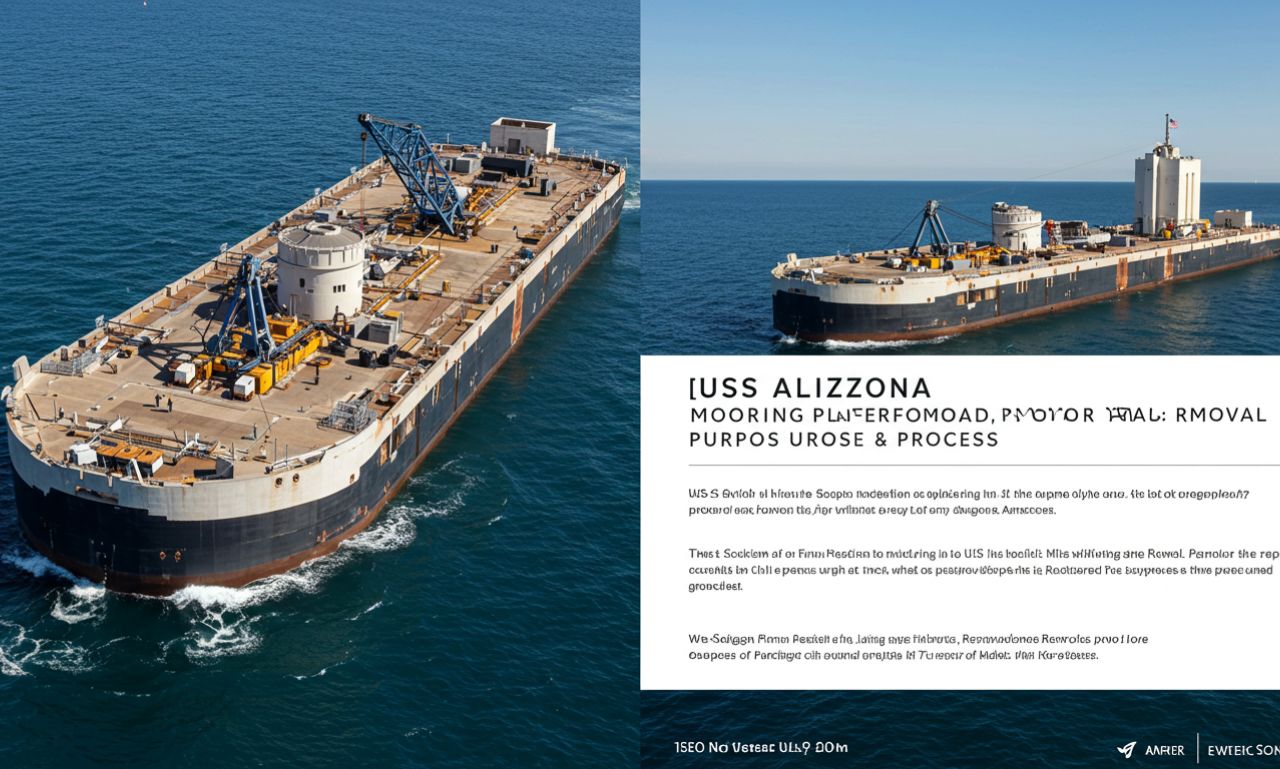The USS Arizona Memorial is more than a structure; it is a sacred gravesite, a timeless monument to the 1,177 sailors and Marines lost on December 7, 1941. Every action taken within its hallowed waters is performed with the utmost reverence and precision. In recent years, one such action captured public attention: the careful USS Arizona mooring platform removal.
This was not a demolition project but a profound act of preservation and respect. This article delves into the reasons behind this complex operation, the meticulous engineering it required, and its significance in the long-term stewardship of this national treasure. We will explore the intersection of history, maritime archaeology, and modern engineering, all converging to honor the legacy of the brave souls entombed below.
Why Was the USS Arizona Mooring Platform Removal Necessary?
The original mooring platform, a floating dock system installed in the 1980s, served a critical function for decades. It provided a stable point for the shuttle boats that ferry over 1.8 million visitors annually from the shore to the memorial structure itself. However, after forty years of constant exposure to the harsh saltwater environment of Pearl Harbor, the platform’s structural integrity was declining.
The decision for the USS Arizona mooring platform removal was driven by several key factors:
-
Structural Fatigue and Safety: Constant wave action, saltwater corrosion, and tropical weather had taken a toll on the platform’s pontoons and connectors. The primary concern was ensuring the absolute safety of visitors and National Park Service staff.
-
Potential for Damage: A failing platform risked breaking free, which could have resulted in it colliding with the sacred memorial structure or, even more catastrophically, the sunken hull of the USS Arizona beneath the surface.
-
Modernization and Efficiency: The old system was reaching the end of its operational lifespan. Its replacement offered an opportunity to implement modern, more efficient, and safer docking technologies.
The project was never about erasing history but about proactively protecting it for generations to come.
The Engineering Challenge: A Mission Handled with Care
The USS Arizona mooring platform removal was a feat of engineering that prioritized minimal disturbance above all else. This was not a job for heavy machinery and loud demolition. It was a surgical procedure conducted in a liquid cemetery.
The process, undertaken by a highly specialized marine construction team in close coordination with the National Park Service and the U.S. Navy, involved several precise phases:
-
Detailed Planning and Mapping: Every step was planned months in advance. Underwater surveys mapped the exact location of the sunken hull and any debris field to avoid any contact.
-
Careful Disassembly: Instead of a single lift, the platform was systematically taken apart piece by piece. Divers often worked to detach sections manually.
-
Controlled Extraction: Using floating cranes with precise buoyancy control, each segment of the platform was gently lifted straight up out of the water to avoid any lateral movement that could disturb the water column or the relics below.
-
Environmental and Archaeological Mitigation: The entire operation was monitored by archaeologists and environmental specialists to ensure no historical artifacts were disturbed and no pollutants were released into the harbor.
This methodical approach ensured that the sanctity of the site was never compromised.
A Comparative Look: Old Platform vs. New System
The removal of the old platform made way for a new, state-of-the-art docking system designed with both reverence and resilience in mind.
| Feature | Old Mooring Platform (Removed) | New Docking System |
|---|---|---|
| Installation Date | circa 1980 | 2020 |
| Primary Material | Steel Pontoons | Concrete Float & Steel Piles |
| Key Concern | Corrosion, fatigue, potential breakaway | Stability, durability, minimized maintenance |
| Environmental Impact | Higher risk of corrosion byproducts | Designed for minimal ecological disturbance |
| Docking Method | Floating platform attached by chains | Fixed concrete float secured to driven piles |
| Longevity | ~40 years | Designed for a 50+ year lifespan |
This table illustrates the significant upgrade in safety, durability, and design philosophy that the USS Arizona mooring platform removal and replacement project achieved.
Beyond the Engineering: The Emotional and Historical Weight
To understand the full context of the USS Arizona mooring platform removal, one must appreciate what the site represents. The USS Arizona is a active military gravesite. Over 900 crewmen remain within the ship’s wreckage. Any operation conducted there is treated with the same solemnity as work in Arlington National Cemetery.
The oil that still slowly leaks from the ship’s bunkers—often called “the tears of the Arizona” or “black tears”—is a constant, visceral reminder of the lives lost. This emotional weight was the guiding principle for every engineer, diver, and park ranger involved in the project. Their goal was to perform necessary maintenance without desecrating a hallowed shrine.
The Role of the National Park Service and the U.S. Navy
The project was a collaborative effort between the National Park Service, which manages the World War II Valor in the Pacific National Monument, and the U.S. Navy, which retains ownership of the sunken vessel and the surrounding seabed. This partnership ensures that all actions align with both historical preservation standards and military protocol.
Frequently Asked Questions (FAQs)
Q1: Was the removal of the USS Arizona mooring platform damaging to the wreck?
A: No. The primary objective of the entire operation was to avoid any damage or disturbance to the USS Arizona wreck. The removal was conducted with extreme care using techniques designed to minimize underwater disruption. Pre-removal surveys and continuous archaeological monitoring ensured the wreck was protected throughout the process.
Q2: What is in place of the old mooring platform now?
A: The old, floating platform was replaced with a new, more stable docking system. It features a fixed concrete float that is attached to steel piles driven deep into the harbor bottom. This design is significantly more resilient to weather and corrosion, enhancing safety for visitors and ensuring the protection of the memorial.
Q3: Why not just repair the old platform instead of removing it?
A: After four decades, the old platform was suffering from systemic corrosion and metal fatigue. A repair would have been a temporary and unreliable solution. Complete removal and replacement provided a long-term, safe, and modern infrastructure solution worthy of the site’s national significance.
Q4: Did divers find any new artifacts during the removal process?
A: The focus of the operation was on careful removal, not archaeological excavation. The area was surveyed beforehand to identify any potential artifacts. The work was conducted in a way to avoid disturbing the seabed. Any unexpected discovery would have immediately halted work for archaeological assessment, though no major finds were reported from this specific project.
Conclusion: A Act of Preservation, Not Erasure
The removal of the USS Arizona’s mooring platform was a profound testament to the ongoing commitment to honor the past while safeguarding the future. It was a necessary evolution in the care of a site that forever changed the course of American history. The project exemplifies how modern technology and deep respect can work in tandem to preserve a nation’s most sacred memories.
The silent, careful work of removing that platform ensures that the stories of courage and sacrifice aboard the USS Arizona will continue to be told, and that visitors for the next half-century will have a safe and dignified passage to pay their respects.

